Giphy Wants All the GIFs
 GIPHY | Search All the GIFs & Make Your Own Animated GIF
GIPHY | Search All the GIFs & Make Your Own Animated GIF

It seems I can’t escape “Dear Evan Hansen.” It’s a new musical. And yes, that’s my name, but no, I’ve got nothing to do with it. Still, every few days, friends and acquaintances have been pinging me with a picture of the ad and clever gambits like: “Secret double life?” “Can you get me tickets?” Rather than get annoyed, I now usually resort to something this:

Simpsons GIFs are incredibly effective. The sequence above was posted on Tumblr on June 22, 2014, by one “neogohan.” I can’t find an earlier version, so this may be the person who first frame-grabbed and shared it. Later it was reposted on Cheezburger.com (a great place to find Simpson’s GIFs, btw), which is the version I took, with a new title added: “No Touchy! No Wakey!”
There are easily millions of copies of Simpsons GIFs of uncertain progeny scattered across the Internet — a veritable arsenal of witty comebacks good for all occasions. These join many millions of other GIFs in common usage, of course. And it’s pronounced GIFF — with a hard “G”.
Sometime in the next few weeks, this unofficial archive is going to get a major facelift. Fox, the producer of the show now airing its 27th season, has been working to cut fresh GIFs from all 593 episodes covering every shareable sequence. It’s a massive stealth project, reported here for the first time, representing a potential watershed for GIF culture as well as the company that’s making it happen on the back end: Giphy.
Giphy co-founder and CEO Alex Chung says they’ll have “every GIFable Simpsons moment,” fully licensed for distribution, tagged with the best metadata professional editorial minds can devise. And it won’t be the last show to get the GIF-360 treatment.

Giphy CEO Alex Chung.GIFs are one of the Internet’s true native art forms next to memes. Anyone who’s been on the Web any time in the past 20 years will have encountered them, first in the form of goofy text animations, and more recently, in campy frame grabs of pop culture video.
In the past three years, though, GIFs have evolved — and so has Giphy. The company is morphing into a full-blown media enterprise with visions of empire. In addition to the Simpsons agreement, it’s inked dozens of licensing deals with America’s most powerful sports and entertainment companies to copy and freely distribute snippets of video drawn from copyrighted material. Giphy has also spun up an artists’ network to produce original GIF content, launched an editorial team of 10 in Los Angeles, and hired its first sports editor from ESPN. In what may be Chung and his team’s biggest run at shifting GIF culture to the mainstream, Giphy is perfecting a real-time GIF engine with ambitions to take every live video feed in the world, cut the best GIFs within seconds, and release them to the public.
Has the janky, crowdsourced era of GIFs just come to an end?
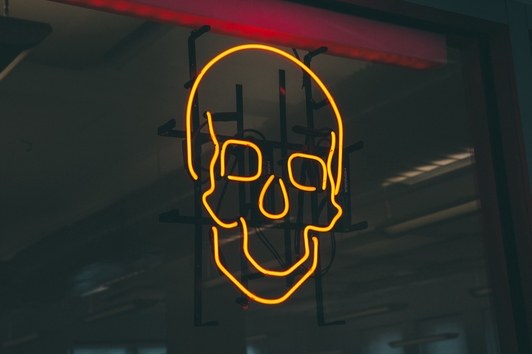
Giphy’s New York City office.
I meet Chung face to face on my third visit to the company’s HQ, a quiet and mostly nondescript open office space at Varick and West Broadway that houses the main operations of what’s widely been dubbed the “Google of GIFs”. Technically, a GIF is simply a kind of digital image format, and not even the best one out there by many standards. But it’s come to represent something much bigger as the underpinning of those short, silent, looping videos found nearly everywhere online these days. GIFs are having a moment as they jump to mobile chat platforms, where people love to use them as a convenient stand-in for text. Some see this shift as the prototype of a fully semantic visual language, a linguistic evolution with legs that’s oozing up from the Internet swamp and taking its first tentative steps on dry land. Early Giphy backer John Borthwick, founder of tech incubator Betaworks, calls this transition the beginning of “post-literate culture.”
That may be hyperbole. But there are several objective forces driving this trend, and the numbers are staggering. Giphy and its various competitors are serving billions of GIFs a day in Web searches, initially through their APIs. Now custom GIF keyboards integrate with iOS and Android (Giphy is launching theirs today), making GIFs available with a simple tap on a wide variety of mobile apps, including iMessenger and Kik. Rumors suggest that Google is about to drop an iOS keyboard app with embedded GIF search, too, and one of Giphy’s main rivals, Riffsy, continues to build momentum with its dominant GIF keyboard app.
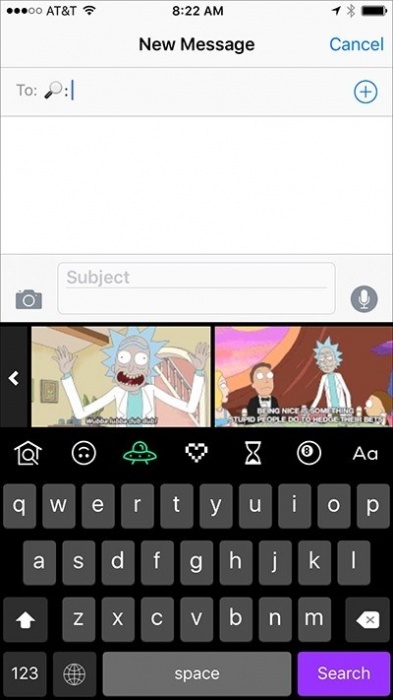
Giphy’s custom iOS keyboard.
Giphy KeysKeyboards would seem to tie the knot for GIFs as a new form of communication, placing them right where people actually communicate the most; but Chung sees them as just one piece in a much bigger GIF universe. “The addressable market for custom keyboards is actually pretty small, a few million,” he tells me. “Fundamentally we see our play as much broader.”
Not only does Giphy pump out a firehose of GIFs through Web search and an API network of Cthulhuian proportions; it’s developed a repository of hundreds of thousands of high quality, publicly available images. Millions more are stored in a dark vault accessible only to Giphy editors, who pick through the trove daily to unearth the very best and share them with the world. It’s developing both GIF creation tools for individuals and industrial-scale, automated methods for converting entire movies into GIF libraries in a matter of minutes. GIFs could soon leap from private reactions and casual entertainment to news highlights, something that’s already happened in sports.

Gif via Giphy created with their creation suite.
If Giphy succeeds, it could represent a massive shift in the way GIFs are produced and shared, effectively moving GIFs from a mostly bottom-up expression of the Internet counterculture to a mostly top-down product led by the marketing agendas of big media companies and brands. While Giphy has not begun working officially with brands or sponsored content, it’s not hard to see how it might turn on the taps once the plumbing has been laid.
“When you have the brand, the content, the distribution and the creation, that’s a pretty defensible position,” says Chung. “When you have all the content in the world and concentrating all this stuff you have a monopoly on, now you really become a search engine.”
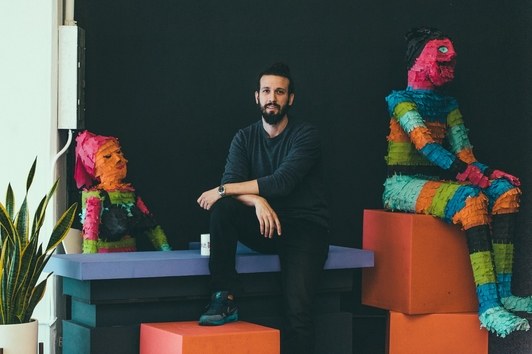
Giphy COO Adam Leibsohn.
Nils Ericson
Ground zero of post-literate culture fits comfortably around 40 desks and sports an assortment of glassed-in conference rooms named after crayon colors based on Giphy’s lo-fi Web site design: Red, Yellow, Blue. Each is hung with a neon restaurant-themed sign variously advertising “Pizza” and late night “PM” service, among others. An 8-bit arcade console and pool table fill out the obligatory in-office entertainment options. Dressed in a plain white v-neck t-shirt, black pants and black sneakers, looking more like a designer than a CEO, Chung directs me towards Yellow.
A serial entrepreneur obsessed with video, Chung’s passion is drawn in equal parts from art and engineering, and goes back to childhood, when he first picked up a camera and started recording everything. “I was one of those annoying people,” he says. Chung estimates he probably has thousands of hours of tapes going back to the 1970s, and says he even kept recordings of his voice mail messages for several years, which he’s now re-recording about an hour each day for fun.
He immigrated to the U.S. from Seoul with his family when he was four, landed in Seattle and attended the University of Washington where he was something of a polymath. He majored briefly in physics (“I realized I wasn’t smart enough”) before settling on concentrations in electrical and computer engineering, as well as international relations and philosophy. He later took an MFA in San Francisco. Drawing inspiration from the Austrian artist Martin Arnold, his thesis explored remixing, film loops and scratching, applying the well-known DJ technique to video. He cites Michael Stephens’ scholarly 1998 pro-TV, pre-Youtube book “Rise of the Image, Fall of the Word” and the philosopher Ludwig Wittgenstein as key influences. Completing a picture-perfect study in surprising contrasts, I learn he has a black belt in Brazilian Jiu Jitsu and trains MMA fighters in Muy Thai from a gym on 28th St.

Nils Ericson
For years, his bucket list has included shipping a “video Polaroid” product incorporating OLED screens, bluetooth streaming, a flexible battery and good old-fashioned kinetic energy: By waving the screen like a Polaroid picture, viewers would see a short, silent, looped video image — “where you could hold movement in your hand,” he says.
Video Polaroid is going to have to wait. Giphy just closed a $55 million series C funding round in February valuing the company at $300 million. It’s a number that inspires envy in startup circles but also some incredulity — the company is “pre-revenue,” COO Adam Leibsohn tells me with an of-course-we-are wave of the hand — so much so in some quarters that I’m surprised there isn’t a “My Face When” joke about it somewhere on Reddit.
Giphy began humbly enough. Chung describes it as “an art project” that evolved out of conversations with his friend Jace Cooke, another serial entrepreneur he’d met at Best Made Co, a woodsy maker of designer axes.
“We’d worked together previously and liked the chemistry,” Cooke tells me. “He’ll never call an idea crazy — often his ideas are way crazier than mine, but he’ll run with an idea longer.”
In 2012, Chung and Cooke were meeting regularly in New York to kick around ideas. They started discussing how hard it was to find good GIFs and how cool it would be if there was a simple GIF search engine.
“We both had collections of GIFs on our desktop, and we were like, ‘Why has Google not done this? Some day we should make a search index for GIFs,’” says Chung. “I even came up with a name — ‘Gifgle.’” It was Cooke who came up with name Giphy, which stuck.
They did some market research and confirmed there was nothing else there in the GIF search market. Tumblr, one of the first and still one of the biggest GIF repositories, was organized around following people, not pinpointing files in its massive collections. (It only launched GIF search in 2015.)
“We were stunned this did not already exist,” recalls Cooke.

About six months after the idea was first hatched, Chung was hired as a Hacker in Residence at tech incubator Betaworks, where he brought the GIF search engine as a pre-existing idea.
Betaworks had just expanded the Hacker in Residence program from one person at a time to six. “I’d met Alex before, and he struck me as a creative thinker, and we talked and I realized he was exactly the type of person we were looking for,” recalls Borthwick.
Chung continued to work on the search index as he dug into new Betaworks projects, developing a GIF crawler based on some clever Google workarounds.
«That summer I was hacking on it and Google still hadn’t done anything with it — it still looked like ’80s tools,” he says. “Then I got in touch with Jace and said, ‘Remember the thing we were talking about? I built it.’”
Recalls Cooke: “We just turned it on one Friday evening. People went nuts.”
The site was featured on Mashable, Techcrunch and Wired, among others, and traffic soared. Friends were called on to help keep the servers from crashing. By Monday a decision needed to be made: Shut it down, or find someone to fund it and see if they could turn Giphy into something sustainable.
“Within hours we had people emailing asking us if they could invest,” recalls Chung. “It took about four hours, I think, before Paul Murphy at Betaworks approached us and said Betaworks would like to do it.”
They secured a $1 million note, and started hiring the core team.
Then came the backlash.

Giphy Design Director Juliana Osso.
Nils Ericson
People loved Giphy. People hated Giphy. The search results were…crappy. Almost all of the underlying images for popular GIFs were taken from copyrighted movies and TV shows, so media companies would need to be appeased. Artist attribution was murky and not well understood. Some long-time GIF artists saw Giphy as a threat. At Tumblr, whose creators were responsible for thousands of the newly indexed GIFs, the launch was viewed at first with suspicion. At Google, the search team scrambled to catch up, and within weeks rolled out its own GIF search feature.

Pau Santesmasses, Product Manager at Tumblr, was part of the team that responded to Giphy after it launched to ensure respectful treatment of its artists and creators. “We had some discussions for several weeks, but it never got so unpleasant we brought in lawyers,” he says. “We worked it out.”
According to Chung, it was all just a misunderstanding. “Tumblr had this historical PTSD of people ripping off artists,” he says. “There were these sites that would spring up and scrape all its content. They were like, ‘Are you one of those sites?’ When we launched we knew we wanted to provide good attribution. We link back to artists and do our best to find the original version. I walked them through our site and was able to show we are better than Google Images at attribution.”
Others remain unconvinced to this day. Ronen V, a creator whose work is highly regarded in the GIF artist community, continues to have deep misgivings about Giphy. “There’s no polite way to talk about what they’re doing,” he says.

Gif creator Ronen V.Chung and Cooke faced another big problem: The raw index was not actually all that useful. GIF tags were incredibly spammy (“every teenage kid tags everything ‘One Direction’ and ‘Bieber,’” gripes Chung), and many of the GIFs themselves were low-quality due to file-size limits on popular sites such as Reddit and Tumblr. And there was a ton of porn. They were forced to manually clean it up, adding good metadata and using Mechanical Turk to get rid of the NSFW files.
“We realized this is why no one had done it, all the metadata is horrible,” says Chung. “There are a lot of costs people don’t realize when you bring content in and index it.” They’d finally discovered why their search engine hadn’t existed before: it was too expensive for anyone but the most committed builders.
“So in the beginning people were saying Giphy search is horrible. Well, the metadata is horrible.”
That was an aha moment that’s guided the company ever since: You can’t use machines to organize GIFs. Math can help, but in the end you need a human eye. “Our bet is culture cannot be algorithmically sorted,” says COO Leibsohn.

Gif via GiphyAnother aha moment came from data. A glance at the queries showed that almost all of the consumption in the search engine was hitting pop culture GIFs drawn from movies and TV. This was a potential copyright nightmare that needed to be solved ASAP. But Chung also saw an opportunity.
“If we could get deals with the rights holders, we could skip right past the YouTube phase of user-generated content and focus on the high end stuff first,” he says. “Then we could add UGC later.”
He saw an added benefit: Partners could help by uploading high-quality content onto the network with clean metadata from the start.
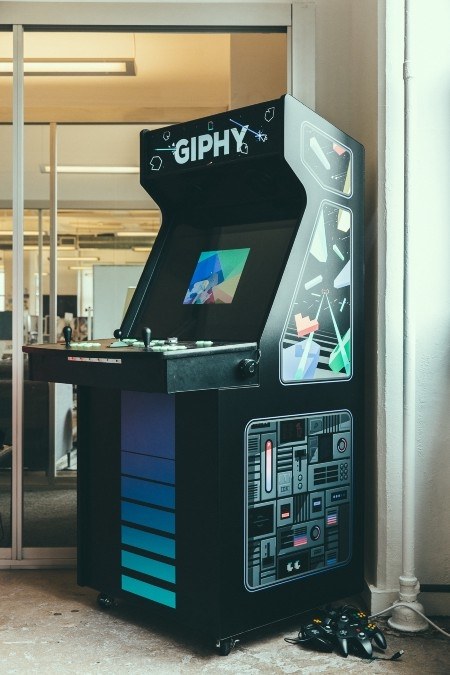
Nils Ericson
Chung brought on an old friend, Leibsohn, who’d worked with him on a social payments startup called IOU, to hammer out licensing agreements with the studios and entertainment companies.
“There were a bunch of other folks that saw the value of animated GIFs and saw something to be done there,” says Kenyatta Cheese, founder of Know Your Memes and more recently the social media consultancy Everyone At Once. “Giphy was the one that said we’re not going be afraid of rights holders, we’re going to go to rights holders and negotiate deals with them directly. And this was before they had taken off.”
Little by little Giphy began replacing its original search index with fresh high-quality versions. It eventually stopped ambient indexing entirely and now relies on partner and user uploads, with heavy manual editing by human curators, who tag GIFs by emotions, among other things.
“Finding good ones is a real art,” says Jack Shepherd, Director of Editorial Strategy at Buzzfeed, one of the first major media outlets to really take advantage of the GIF. “Which is probably why Giphy is so successful, because they are building this library based on things you might want to find rather than the old way where you literally had to have 500 funny GIFs sitting in a folder somewhere and remember, ‘What’s that one with the kid who falls over?’”
As Giphy knocked off one potentially company-killing problem after another, the pressures of running a startup were mounting steadily. Chung had just come off of two other startups and didn’t want to be CEO, so the job fell to Cooke. “I drew the short straw,” he says.
Within months, the arrangement fell apart. Cooke left Giphy and Chung found himself reluctantly in the CEO role.
Chung and Cooke give mostly similar accounts of how the split went down. I reached Cooke by phone. He’s now rambling in a camper van in what appears to be self-imposed digital detox. The CEO mantle simply did not fit, he says.
“I was unhappy in New York,” he told me. “The role of CEO burned me out very quickly. I considered moving to something more fun or ceremonial, but that would have required me to still be involved and committed emotionally. I needed to make a big personal change. Alex and I had had conversations about that. He decided to take over as CEO and we departed on good terms.”
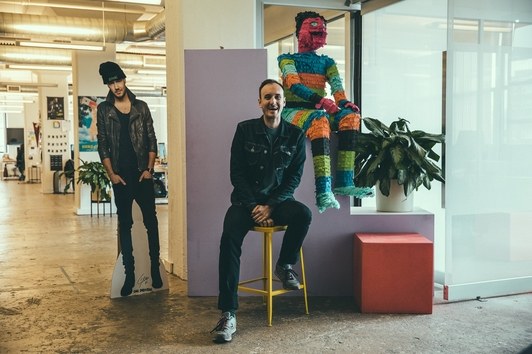
Giphy Editorial Director Tyler Menzel.
Nils Ericson
Giphy’s original tag line was “You’re Welcome.” These days it is “All the GIFs.” Though Giphy was the first to take a credible crack at chasing all the GIFs, it is not the only company doing so. Google has shored up its GIF search, and is expected to go one further with GIF search integrated into a custom keyboard for iOS within weeks. “As of now, you can search for GIFs the same way you would for anything else: Just type or say to Google ‘(show me) dog gifs’. I just spent way too much time looking at the cuteness that came up!” a Google spokesperson wrote in an email.

It’s an open question why Google waited so long to tackle GIFs, but a common refrain in the GIF community is that the problem was simply not something Google is good at solving.
“Google are generally bad at anything that requires feelings, empathy, or design” says Ronen V. “You can often boil these companies down to their inception, and Google is a very particular one: Google is the biggest number, and they solve problems with math. …Right after Giphy launched, Google added a GIF search, and it is still so crappy you can’t really use it.”
Tumblr, widely recognized as the first major repository of GIFs, has rolled out a slew of new features to make GIFs more discoverable, including search and a GIF Maker last year, winning some praise for its efforts.
“I think Tumblr is — it is just a relatively darker space for it,” says Cheese, even though, he adds, “In my history book, I attribute about 90 percent of the rise of GIFs to Tumblr.”
Riffsy, the keyboard app maker, is also nipping at Giphy’s heels. The company declined to be interviewed for this story. While it is smaller, it offers an alternative model for building out a high-quality, searchable GIF repository based on algorithms and community. Like Giphy, Riffsy’s selections are catalogued by emotions, zeroing in on the reaction GIFs that spread through the mobile networks where it is embedded. It relies on community uploads and keys in on sentiment by carefully mining the rich data users provide to track what’s trending and popular. As a result, its recommendations are constantly changing based on what’s happening in the world, and the community. And they are not taking on the overhead of an editorial team of the kind Giphy is building, a cost that’s often assumed to be unsustainable at the scale of content being moved through these types of networks. It, too, has brokered content deals with studios. Recently Riffsy users shared over 100 million Minions GIFs with the launch of the latest movie in the franchise, according to people familiar with the data.
Giphy is planning on rolling out its own community filters sometime this year. “Curation is hard to scale,” Chung admits. “We’re currently building a bunch of tools to bring in a wave of community members. How cool would it be to say you are now the master of pizza GIFs, you get to pick the best ones?”

Looking back at Giphy’s evolution, the contours of a savvy, long-range strategy are visible from the start. For an art project, it’s been engineered with astute discipline. The sequence: First, get all the best content through aggregation. Second, establish the brand, win SEO for GIFs. Third, build out distribution. Fourth, own creation and develop original content. Fifth, push the form to the max.

Each step has been carefully executed in a series of one-year plans, a time frame Chung says is just long enough “to know when it’s time to quit,” if things aren’t working out.
Having built its content library, Giphy broke out seriously with its API platform, which has steadily grown into a formidable distribution network. “Two and half years ago, apps like Facebook were not 100 percent sold on GIFs,” recalls Nam Nyguyen, Director of Platform Products, who took charge of the API shortly after arriving at the company. Undeterred, Giphy hacked its way into Facebook, using a SWF player and transcoding GIFs to serve the video inside a Flash wrapper. Facebook would eventually come around, integrating Giphy in early 2015. Giphy landed Twitter earlier this year and now it plumbs almost all of the major apps, and thousands of lesser ones. It also powers hundreds of bots, including a very popular Slack bot that serves a single seemingly random GIF when prompted by a keyword.
Like a lot of people, I first became aware of Giphy through that Slack bot. We use it constantly at Medium, and the results are often so bad it’s funny. Interacting with the bot is like playing GIF roulette with a potato gun. People love it, and it’s interesting to think about why, what it says about GIF search, and what it means that people would love a bad search result.
No one loves or shares bad Google search results. But GIFs seem to be different. They carry emotional overtones. They almost demand a reaction. The right GIF, delivered at the right time, to the right person, has the punch of the perfect inside joke. They are made for social exchange.
The Giphy Slack bot is basically a game. And if you’d studied your Wittgenstein, you wouldn’t be surprised to hear language itself described essentially as a game.
When some colleagues learned I was writing a story about Giphy, they demanded I get to the bottom of how its Slack bot works. Not surprisingly, it has an interesting backstory that says as much about Giphy as it does about GIF search. The team was screwing around on HipChat, their chat tool of choice at the time. They’d built a bot that delivered a GIF based on keywords. In the beginning, it would simply pull the result from a list inside the tag. If the search result was good, they’d keep it. As an experiment, they decided to add some randomness just to see what would happen.
“One thing we do as a group is if we like a feature we will ship it the world,” says Nyguyen. “And what we found was we were using the bot more than we were chatting with each other because we wanted to see what would come up… And we personally enjoyed it, because when it was wrong it was either so wrong it was awesome, or so wrong we’d just keep going. And we thought that’s an interesting behavior, so let’s see what the world will do with it.”
While its website draws 150 million uniques a month, Chung sees it as an afterthought compared to its API and bot networks. “I never really expected the website to be a big draw; the goal all along was to be everywhere.”
Chung describes his team as bunch of experimenters and “weirdos,” a phrase that’s echoed by other members of team. They’re a tight knit group, many of whom have worked together in the past and who all pass what Chung calls the road trip test, “which is basically, could you stand to spend months together in close quarters for hours a day, like you would in a tour bus?” It’s a requirement that’s put to high test each year, when the entire Giphy team heads en masse to hang out and work in Los Angeles for a month.
Another job requirement is having a deep and almost unnatural love of GIFs. Design Director Juliana Ossa was in search of something different when she was recruited from the world of big ad agencies. “They were like, ‘Do you like GIFs?’ And I was, ‘I talk in GIFs!’”
With the third ladder step of distribution beneath it, Giphy now stands firmly between the fourth and fifth rungs. In a marathon meeting with the company earlier this month, the engineering team showed me demos of a bevy of new content creation tools allowing anyone to make GIFs on desktop and a smartphone, and gussy them up with filters and stickers, features reminiscent of Snapchat’s user creation tools.
Giphy is now pressing hard to bend the form to the breaking point. It is investing heavily in real-time “live GIFing,” grabbing GIFs from events like the Oscars, Kobe Bryant’s last game, the TriBeCa film festival red carpet and spitting them out before the evening is done. It’s a skill, like many others, they’ve had to learn on the fly.

“Two summers ago we were doing one of our very first live GIFs ever with ‘So You Think You Can Dance,’ you know, that TV show,” says Editorial Director Tyler Menzel. “And we were trying to do it, our Internet feeds were breaking and we were so miserable. And we were, like, ‘How are we going to do this?’ We were 10 people and trying to make 15 GIFs, and how are we going to do this? Smash cut to: we are on the red carpet at the Oscars and producing 350-plus GIFs.”
As the afternoon sun draws longer shadows on the floor, Director of Business Development David Rosenberg walks me through some power user tricks, where the company is experimenting with embedding information in GIFs, such as delivering weather and stock reports. Some companies are already using its bots, triggered by key events like a sale, to send a congratulatory “Make It Rain” GIF to the team, for example.
“How can you deliver information as a GIF? So if you were to go to Food Network and show me how to make a pie in a GIF, or The New York Times and show me the jobless rate as a GIF,” says Rosenberg.
After three days hanging out with Giphy, at times it seems like they are the proverbial hammer that sees every problem as a nail; lurking behind every media type is a GIF in the making, a GIF to be plucked.
“I’ll be honest, I had a meltdown a couple of months ago,” confesses Nyguyen. “I was like, Guys GIFs are a fad, it’s going to go away, we pushed it too far. And I remember this one person said, Are your really worried? I said Yes. They said, Don’t be. GIFs have been around from the start of the Internet. As popular as it is, it won’t go away.”
The pang didn’t last long.




